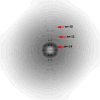Three-dimensional reconstruction of helical polymers
- PMID: 25912526
- PMCID: PMC4543434
- DOI: 10.1016/j.abb.2015.04.004
Three-dimensional reconstruction of helical polymers
Abstract
The field of three-dimensional electron microscopy began more than 45years ago with a reconstruction of a helical phage tail, and helical polymers continue to be important objects for three-dimensional reconstruction due to the centrality of helical protein and nucleoprotein polymers in all aspects of biology. We are now witnessing a fundamental revolution in this area, made possible by direct electron detectors, which has led to near-atomic resolution for a number of important helical structures. Most importantly, the possibility of achieving such resolution routinely for a vast number of helical samples is within our reach. One of the main problems in helical reconstruction, ambiguities in assigning the helical symmetry, is overcome when one reaches a resolution where secondary structure is clearly visible. However, obstacles still exist due to the intrinsic variability within many helical filaments.
Keywords: Direct electron detectors; Helical polymers; Variable twist.
Copyright © 2015 Elsevier Inc. All rights reserved.
Figures




References
-
- Barrett AN, Leigh JB, Holmes KC, Leberman R, Mandelkow E, von Sengbusch P. An electron-density map of tobacco mosaic virus at 10 Angstrom resolution. Cold Spring Harb Symp Quant Biol. 1972;36:433–448. - PubMed
Publication types
MeSH terms
Substances
Grants and funding
LinkOut - more resources
Full Text Sources
Other Literature Sources

